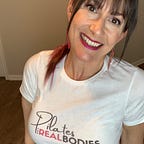Five Pilates Moves for Excellent Hip Health
Your healthy hips are vital to a healthy life. Hip pain can impact the simplest tasks that make up your day like walking, using stairs, and even sitting. Tight, immobile hips cause problems with our back and posture. Hip health isn’t so much about making the hip muscles strong as they are about keeping them strong and flexible. Mobility is everything to the hip joints and Pilates is a perfect format for this goal.
The hip joint and accompanying muscles are complicated! We will stick to the basics here:
- The hip joint is a ball-and-socket joint. The femoral head sits in the acetabulum, a socket in your pelvis.
- Ligaments hold the joint in the socket, while major and minor muscle groups move the hip joint in all of its possible directions: flexion/extension (forward/back), abduction/adduction (open/close), internal/external rotation, circumduction. (See below for examples of each movement.)
- The larger muscles that move the hip joint include gluteals, adductors (inner thigh), quadriceps, and hamstrings. We typically strengthen those with squats and lunges.
- The smaller muscles make up the hip flexor group, a vital part of hip movement.
What Are the Hip Flexors?
This group of muscles is small and internal and without them, we can’t lift our knee to our chest. They also work to stabilize the core muscles and spine.
- Psoas major: The psoas muscle is the only muscle that connects your spine to your leg. It runs from your lower back through your pelvis and attaches to the front of your femur.
- Iliacus: The iliacus is a flat, triangular muscle deep within your pelvis. It flexes and rotates your thigh.
- Rectus femoris: One of the four quadriceps muscles, it attaches your pelvis to the patellar tendon of your knee.
- Pectineus: Often referred to as your groin muscle, the pectineus muscle lies flat on your inner thigh. It’s primarily responsible for hip flexion, but it also rotates your thigh and adducts.
- Sartorius: The sartorius muscle is a long thin muscle that runs from the outer thigh down the front of the thigh and attaches to the inside of the knee. It helps flex the knee and leg.
Our hip flexors do a lot of directional work and because they lie close to the bone, they are harder to stretch and strengthen. Our hip flexors get tight from being in a shortened position when we sit for long periods of time. This tightness can lead to all kinds of pain and discomfort, especially in our low back. We need to maintain mobility in these muscles, which means keeping them strong and flexible. This is what Pilates is designed to do!
Pilates Exercise for Hip Health:
I am focusing on a side-lying series but Pilates includes many exercises that work the hips. In this series the leg moves in many different directions, working many muscles at once. (As with most Pilates exercises, you keep your core engaged to hold your upper body solid. You shouldn’t rock as you work the leg.) You can perform them laying down completely, holding your head up in your hand, or propped up on your elbow depending on how much balance challenge you are going for.
Leg Kicks:
This forward and back kick works most of the thigh muscles while giving a nice stretch to the hamstring with the front kick and the hip flexor group with the back kick.
External Rotation:
Most of us don’t think much about externally rotating the hips unless we are dancers — yet without the movement, we would walk like robots! Lubricate the hip with this move and keep that rotation available! (In my Pilates class, I rarely internally rotate the hip. That’s why the foot in the second picture is only facing forward and not down.)
Adductor/Abductor Kicks:
This kick needs to be performed with the foot facing forward so that you use your inner and outer thigh muscles. Otherwise, with the foot turned to the ceiling, you are working the quads. Another important cue is to move the leg with control — don’t fling the leg. Lift and lower it with intention and power.
Leg Circles:
Pilates is known for its leg circles! Here, we are working to hold the upper body steady as we move the leg around in the hip joint. Laying down will give you a bigger leg circle based while being up in the elbow is a greater balance challenge.
Again, this is a small sample of how Pilates helps your hip joint and the attaching muscle groups. See for yourself by coming to a class! I have a free beginner class each Friday at 10 am. Sign up here!
Linda Magid has taught group fitness classes for over 7 years. She is certified with AFAA and AEA, with special certifications in Pilates, TRX, and more. You can find her Pilates studio at https://pilatesforrealbodies.com. Contact her at @LindaMagidFitness on Facebook and Instagram.
